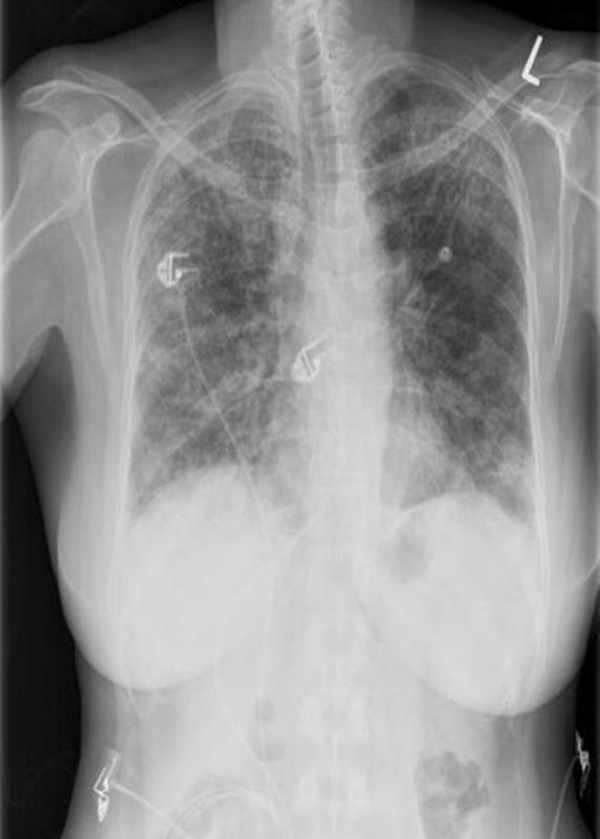WBR0314
| Author | [[PageAuthor::Ogheneochuko Ajari, MB.BS, MS [1] (Reviewed by Yazan Daaboul, M.D.)]] |
|---|---|
| Exam Type | ExamType::USMLE Step 1 |
| Main Category | MainCategory::Microbiology |
| Sub Category | SubCategory::Pulmonology, SubCategory::Infectious Disease |
| Prompt | [[Prompt::A 22-year-old female military recruit presents to the emergency department (ED) with complaints of malaise, persistent cough, and low-grade fever for the past 3 weeks. She states that her symptoms have gradually worsened over time. She tried taking over-the-counter medications to relieve her symptoms, but her condition did not improve. Upon further questioning, the patient reports that other recruits in the military base had similar complaints recently. Chest x-ray is performed in the ED and is shown below. What is the most
Sputum culture grew an organism in a complex acellular medium enriched with cholesterol. Which of the following organisms is the likely cause of the patient’s symptoms?]] |
| Answer A | AnswerA::Klebsiella pneumonia |
| Answer A Explanation | [[AnswerAExp::Klebsiella pneumonia is a common cause of lobar pneumonia in diabetics, hospitalized and alcoholic persons. Cough is productive of red currant jelly sputum. It is also a cause of nosocomial urinary tract infection]] |
| Answer B | AnswerB::Mycoplasma pneumonia |
| Answer B Explanation | AnswerBExp::See Explanation |
| Answer C | AnswerC::Streptococcus pneumonia |
| Answer C Explanation | [[AnswerCExp::Streptococcus pneumonia cause lobar consolidation on chest X ray and associated with a rusty sputum and sepsis in sickle cell anemia. It is the most common cause of Meningitis, Otitis media, Pneumonia and Sinusitis (MOPS). It is lancet-shaped, encapsulated and produces IgA protease. It grows on standard unenriched blood agar but cannot grow in the presence of optochin or bile]] |
| Answer D | AnswerD::Haemophilus influenzae |
| Answer D Explanation | [[AnswerDExp::Haemophilus influenzae causes epiglottitis (cherry red in children), Meningitis, Otitis media and Pneumonia. It is a small gram-negative rod, produces IgA protease and cultured on chocolate agar which requires factors V (NAD+) and X (hematin) for growth]] |
| Answer E | AnswerE::Legionella pneumophilia |
| Answer E Explanation | [[AnswerEExp::Legionella pneumophilia causes severe pneumonia and fever in a condition called Legionnaires disease. It is a gram-negative rod that stains poorly with gram stain. Silver stain is used in the culture media. It grows on charcoal yeast extract culture with iron and cysteine and detected clinically by the presence of antigen in urine]] |
| Right Answer | RightAnswer::B |
| Explanation | [[Explanation::The infection is caused by Mycoplasma pneumonia. This is a classic cause of atypical “walking” pneumonia. Patients experience a chronic nonproductive cough, headache, low-grade fever and malaise. A clinical clue is a chest X ray that looks worse than the patient’s clinical state. Mycoplasma pneumonia requires cholesterol to grow. It has no cell wall, no capsule and not seen on gram stain. It is the ONLY bacterial membrane containing cholesterol. It is seen in frequent outbreaks in military camps and prisons. It has a high titer of cold agglutinins (IgM), which can agglutinate or lyse Red Blood Cells and it is grown on Eaton’s agar.
Chest x-ray demonstrates diffuse, patchy bilateral interstitial infiltrates |
| Approved | Approved::Yes |
| Keyword | WBRKeyword::Persistent cough, WBRKeyword::Cough, WBRKeyword::Respiratory Infection outbreaks, WBRKeyword::Pulmonary infiltrates, WBRKeyword::Cholesterol rich culture medium |
| Linked Question | Linked:: |
| Order in Linked Questions | LinkedOrder:: |
